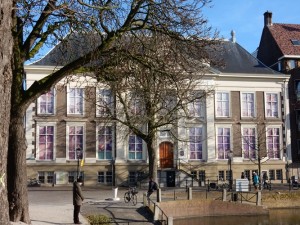January 20 is the saint’s day of Saint Sebastian. Paintings of this saint show an almost naked young man, pierced with arrows. He received this punishment in the third century AD by order of his boss, the Roman Emperor Diocletianus. Sebastian was the commanding officer of the imperial guard and had secretly converted to Christianity. However, Diocletanus had declared himself ‘dominus et deus’ (ruler and god), and that left no room for another, Christian god.

So Sebastian took a huge risk when he turned to Christianity. And he even took a step further, helping fellow Christians who were persecuted by the Emperor. It was to be expected that he fell from the Emperor’s grace when the latter found out that Sebastian had changed sides. After his canonization, Sebastian became the patron saint of archers, a token of Christian clemency.
Saint Sebastian’s Guild
In the 16th century, The Hague had a ‘Schuttersgilde’ named after Saint Sebastian. In the times of the Republic of the Seven Provinces, this guild of archers provided defensive military support for the local civic authority. The members were expected to buy their own weapons and uniforms. A very Dutch approach: the citizens were responsible for the defense of The Hague and the keeping of the peace, without cost to the local government.
Doelen: practice grounds
 The archers trained at practice grounds called Doelen (targets),located in the area between present-day de Korte Vijverberg, Tournooiveld, Lange Houtstraat en Doelen(!)straat. The Saint Sebastian Guild also owned a building for indoor practice and meetings. This building became too small by the end of the 16th century. To raise money, parts of the practice grounds were sold. A small piece of the Hofvijver was filled to create a street now known as de Korte Vijverberg. Here were erected a number of posh houses as well as new accommodations for the Saint Sebastian Guild.
The archers trained at practice grounds called Doelen (targets),located in the area between present-day de Korte Vijverberg, Tournooiveld, Lange Houtstraat en Doelen(!)straat. The Saint Sebastian Guild also owned a building for indoor practice and meetings. This building became too small by the end of the 16th century. To raise money, parts of the practice grounds were sold. A small piece of the Hofvijver was filled to create a street now known as de Korte Vijverberg. Here were erected a number of posh houses as well as new accommodations for the Saint Sebastian Guild.
What’s left today of Saint Sebastian
The Saint Sebastian Guild’s building on de Korte Vijverberg now houses the Historical Museum of The Hague. It was built in a style known as Dutch Classicist and finished in 1636. The architect is believed to be Arend van ‘s-Gravenzande.
The Archers’ Guild lives on in an association called ‘Sint Sebastiaen’ that offers recreational and competitive facilities for archery. Should you be walking on the Korte Vijverberg, fear not that you will suffer the same fate as Saint Sebastian! This association’s practice grounds are situated in Wassenaar, outside of The Hague.
I tell you more about archers’ guilds and their accommodations in The Hague during my city walk ‘Historic The Hague’



4 thoughts on “Saint Sebastian and the Archers’ Guild”
He received this punishment in the third century BC by order of his boss, the Roman Emperor Diocletianus.
BC should be AD!
Indeed, thanks!
Pingback: Sint Sebastiaan en zijn doelen
Pingback: Sint Joris | De heilige die vocht tegen de draak als symbool van het kwaad